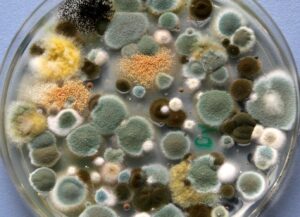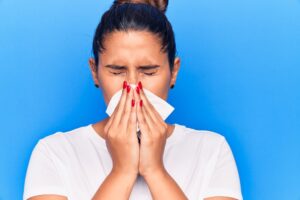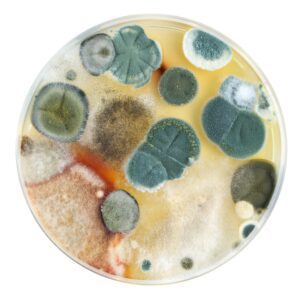Allergies to Mold, Mildew, Yeast, and Fungus
 It is quite common for individuals to be allergic to mold, particularly in the Washington, DC, Northern Virginia, and Maryland metropolitan area. Not only is the humidity elevated in this region, but Washington, DC was built on a swamp. In the Spring, it rains quite often contributing to an increase in moisture and thus mold. In the Summer, the metro area tends to be hot and humid which is ideal for mold growth. During the Fall, the leaves fall from the trees and get wet which is the perfect environment for the development and progression of mold. Even during the Winter mold can flourish particularly since mold lives both indoors and outdoors. In the home, molds tend to be more prevalent in bathrooms, kitchens, and basements, where moisture is more common. It is interesting to note that some molds can survive in very arid environments such as a desert. Any way you slice it, mold is year-round problem for residents and visitors of the Washington, DC metropolitan area.
It is quite common for individuals to be allergic to mold, particularly in the Washington, DC, Northern Virginia, and Maryland metropolitan area. Not only is the humidity elevated in this region, but Washington, DC was built on a swamp. In the Spring, it rains quite often contributing to an increase in moisture and thus mold. In the Summer, the metro area tends to be hot and humid which is ideal for mold growth. During the Fall, the leaves fall from the trees and get wet which is the perfect environment for the development and progression of mold. Even during the Winter mold can flourish particularly since mold lives both indoors and outdoors. In the home, molds tend to be more prevalent in bathrooms, kitchens, and basements, where moisture is more common. It is interesting to note that some molds can survive in very arid environments such as a desert. Any way you slice it, mold is year-round problem for residents and visitors of the Washington, DC metropolitan area.
Mold is a fungus that grows in the form of multicellular filaments that are known as hyphae. There are over 400,000 types of molds. Mildew is also a fungus that closely resembles mold. Mold typically looks fuzzy in appearance while mildew characteristically is flat in appearance. The color of mold tends to be black, blue, green, or red whereas the color of mildew tends to be white, brown, or gray. Mold and mildew produce undesirable odors that many people find offensive or downright problematic as they can cause “sicknesses” to those exposed. Fungi that grow in a single-celled environment are called yeasts. Regardless of their characteristics, mold, mildew, and yeast can all play havoc to individuals who are either sensitive or allergic to them. Regarding allergies to mold, mildew, yeast, and fungi, an allergy to any one of them is generally grouped into one category as “allergy to mold,” as opposed to an allergy to mildew, an allergy to yeast, or an allergy to fungi.
Molds produce tiny microscopic which are their reproductive structures. The diameter of a mold spore generally varies between 3 to 45 microns which is less than half the width of a typical human hair. The mold spores begin are released into the air and since they are tiny in size, they are able to float in the air, where they can be easily inhaled by sensitive individuals. Mold spores flourish in any milieu with a constant source of moisture. As mold grows, the tiny spores begin to undergo chemical reactions that allow them to consume nutrients and further replicate. These chemical reactions produce fumes which are released into the atmosphere. These fumes are responsible for the unpleasant musty odor that everyone is familiar with.
Mold generally can cause annoying symptoms in 4 different ways. The first is from a true allergy to the mold. The most common type of symptoms from mold allergy are the kinds of symptoms one may experience from other environmental allergens such as dust mites, pollens, pets, or cockroaches. These allergic rhinitis (i.e., hay fever) and allergic conjunctivitis (i.e., eye allergies) symptoms may include sneezing, runny nose, post-nasal drip, nasal congestion, itchy throat, sore throat, sinus headaches, snoring, itchy eyes, watery eyes, puffy eyes, and/or redness of the eyes. Severely affected individuals as well as asthmatics may also develop asthma symptoms or an exacerbation of their asthma which may include wheezing, chest tightness, coughing, and/or shortness of breath. The diagnosis of mold allergy necessitates a comprehensive history and physical examination in conjunction with allergy testing (skin tests and/or blood tests). The treatment of mold allergy always begins with prevention. Avoiding mold is always preferable if at all possible. Some of the ways to help reduce mold exposure may include decreasing outdoor activities when mold counts are high, repairing any leaks, lowering the humidity, using a dehumidifier, using air conditioner with a HEPA filter, removing carpets in locations where they are in danger of becoming wet, and masking when engaging in yardwork. The treatment of mold allergy consists of allergy medications (e.g., antihistamines, decongestants, nasal corticosteroids, nasal antihistamines, leukotriene antagonists, eye drops, asthma inhalers) to help relieve one’s symptoms. Allergy shots (i.e., allergy injections, allergy immunotherapy, allergy desensitization, allergy hyposensitization) are extremely effective in the treatment of mold allergy. They are effective in 80-85% of the patients who receive them. Allergy injections have been given in the U.S. for more than 100 years as they get more to the root of the underlying problem by allowing a patient to develop protective antibodies against mold as well as other allergens such as dust mites, pollens, pets, and/or cockroach.
An unusual allergy to mold exists in roughly 1-2% of individuals with asthma. These individuals have an allergic reaction to a specific type of mold known as Aspergillus fumigatus. Similarly, between 2-15% of children with cystic fibrosis have the same reaction to this same mold. Asthmatic and cystic fibrosis patients that react to this mold have a condition known as allergic bronchopulmonary aspergillosis (ABPA). The symptoms of ABPA are similar to that of asthma except they may also cough up sputum with brownish flecks and they may also have a mild low-grade fever. Such patients should be worked up for ABPA via X-rays/CT scans, pulmonary function tests, sputum cultures, blood tests, and allergy skin tests. The treatment of ABPA usually involves the use of medications to treat asthma with the possible addition of oral corticosteroids and/or antifungal medications.
The second way mold can affect an individual is from a non-allergic irritant reaction. Molds can release substances known as volatile organic compounds (VOC’s) which can irritate skin and mucus membranes inside the mouth, nose, and eyes resulting in burning sensation of the skin, itchy throat, runny nose, itchy eyes, watery eyes, and/or cough. Avoidance is the best way to prevent irritant reactions. Using air filters may also be of help.
The third manner in which a mold can cause bothersome symptoms is via a toxic reaction usually by way of inhaled or ingested toxic compounds called mycotoxins, which are produced by the mold. The molds that produce mycotoxins can pose serious health risks to humans and animals. Some studies claim that the exposure to high levels of mycotoxins can result in neurological complications and prolonged exposure may be particularly harmful. The research on the health effects of these types of molds is somewhat controversial and it has not been conclusive. The term “toxic mold” refers to molds that produce mycotoxins, such as Stachybotrys chartarum and not to all molds in general. Mold remediation by a professional mold remediation service is the best way to remedy this situation.
The fourth method in which a mold can cause unwanted symptoms is by causing an infection. This results from the growth of a pathogenic mold within the body. The most common way that molds/fungi cause infections is through the skin. It should be noted that different types of molds/fungi can cause infections in other organ systems which may lead to gastrointestinal, respiratory, and/or neurological problems. Antifungal medications and occasionally other medications are used in order to eliminate the fungal infection.
The board certified allergy doctors at Black & Kletz Allergy will promptly respond to any questions regarding mold allergy or any other allergic or immunologic disorders. We have been treating mold allergies for more than 50 years and have offices in Washington, DC, McLean, VA (Tysons Corner, VA), and Manassas, VA. We have been serving the Washington, DC, Northern Virginia, and Maryland metropolitan area for a long time and treat both pediatric and adult patients. All 3 offices at Black & Kletz Allergy offer on-site parking and the Washington, DC and McLean, VA offices are Metro accessible. There is a free shuttle that runs between our McLean, VA office and the Spring Hill metro station on the silver line. If you are concerned that you may have a mold allergy or any other allergy, asthma, sinus, skin, or immunology problem(s), please call us to schedule an appointment. You may also click Request an Appointment and we will answer within 24 hours by the next business day. At Black & Kletz Allergy, we strive to improve the quality of life in allergic and asthmatic individuals in a professional and compassionate environment.

 Nasal polyps (i.e., nasal polyposis) are soft, benign growths that develop from the lining of the sinuses and nasal cavity. Approximately 4-5% of the general population has nasal polyps. They look like glistening moist grapes and are typically in the shape of teardrops. These new growths result from chronic inflammation of the tissues inside the nasal and sinus cavities. When the nasal polyps grow large enough, they may obstruct the nasal passages which will block the flow of air through the nose. The mechanical obstruction may also block the passage of secretions from the sinuses into the nose which may result in the predisposition of individuals to develop recurrent or chronic sinus infections.
Nasal polyps (i.e., nasal polyposis) are soft, benign growths that develop from the lining of the sinuses and nasal cavity. Approximately 4-5% of the general population has nasal polyps. They look like glistening moist grapes and are typically in the shape of teardrops. These new growths result from chronic inflammation of the tissues inside the nasal and sinus cavities. When the nasal polyps grow large enough, they may obstruct the nasal passages which will block the flow of air through the nose. The mechanical obstruction may also block the passage of secretions from the sinuses into the nose which may result in the predisposition of individuals to develop recurrent or chronic sinus infections.
 There are different mechanisms that play a role in the causation of adverse and undesirable effects triggered by the consumption of food. In the world of food allergies, It is important to distinguish between these mechanisms in order to arrive at an accurate diagnosis. Allergy, intolerance, and sensitivity to foods require different diagnostic approaches including a careful history and skin or blood testing in order to diagnose the condition. The management of these conditions also varies based on the underlying mechanisms.
There are different mechanisms that play a role in the causation of adverse and undesirable effects triggered by the consumption of food. In the world of food allergies, It is important to distinguish between these mechanisms in order to arrive at an accurate diagnosis. Allergy, intolerance, and sensitivity to foods require different diagnostic approaches including a careful history and skin or blood testing in order to diagnose the condition. The management of these conditions also varies based on the underlying mechanisms. So, you have a runny nose, nasal congestion, sneezing, post-nasal drip, sore throat and coughing and it is the Summertime. Are you confused? You thought allergies occur in the Spring and Fall. You thought that “colds” occur in the Fall and Winter. Well, both “colds” and allergies can occur anytime and Summer is no exception.
So, you have a runny nose, nasal congestion, sneezing, post-nasal drip, sore throat and coughing and it is the Summertime. Are you confused? You thought allergies occur in the Spring and Fall. You thought that “colds” occur in the Fall and Winter. Well, both “colds” and allergies can occur anytime and Summer is no exception. Allergic reactions can sometimes be life-threatening. Anaphylaxis is a severe allergic reaction that is characterized by a sudden onset of symptoms with rapid progression. The manifestations may include
Allergic reactions can sometimes be life-threatening. Anaphylaxis is a severe allergic reaction that is characterized by a sudden onset of symptoms with rapid progression. The manifestations may include  Mold allergies are very common, particularly in the
Mold allergies are very common, particularly in the  Mammalian meat allergy which is also known as alpha-gal syndrome causes an immediate hypersensitivity reaction hours after eating beef, pork, lamb, venison, or any other mammalian meat product. Although the allergy was first described in patients with
Mammalian meat allergy which is also known as alpha-gal syndrome causes an immediate hypersensitivity reaction hours after eating beef, pork, lamb, venison, or any other mammalian meat product. Although the allergy was first described in patients with